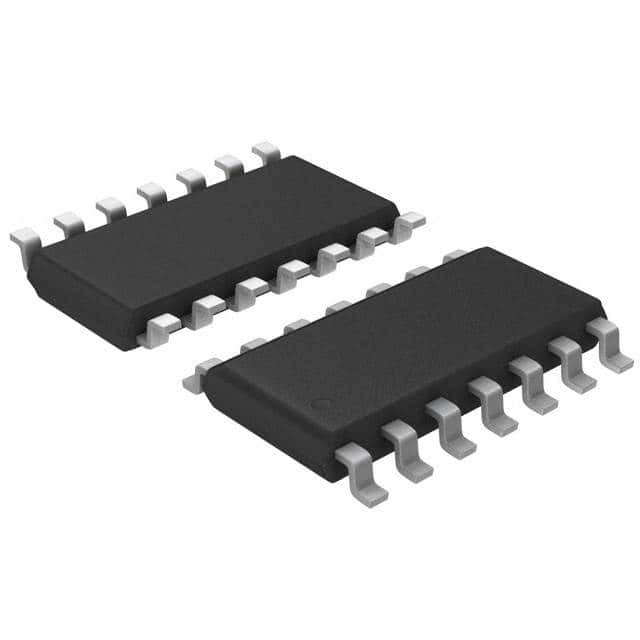MAX8215ESD+ - English Editing Encyclopedia Entry
Product Overview
Category
The MAX8215ESD+ belongs to the category of voltage supervisors.
Use
It is primarily used for monitoring and controlling voltage levels in electronic circuits.
Characteristics
- The MAX8215ESD+ is a highly reliable and accurate voltage supervisor.
- It operates over a wide range of input voltages, making it suitable for various applications.
- This device offers adjustable threshold voltage settings, allowing flexibility in voltage monitoring.
- It has a low quiescent current, ensuring minimal power consumption.
- The MAX8215ESD+ provides both active-high and active-low outputs for easy integration into different systems.
Package
The MAX8215ESD+ comes in a small surface-mount package (ESD) for convenient installation on circuit boards.
Essence
The essence of the MAX8215ESD+ lies in its ability to monitor and control voltage levels effectively, ensuring the proper functioning of electronic systems.
Packaging/Quantity
This product is typically packaged in reels or tubes, with a quantity of 250 units per package.
Specifications
- Input Voltage Range: 1.6V to 6.0V
- Adjustable Threshold Voltage Range: 0.4V to 5.5V
- Quiescent Current: 10µA (typical)
- Output Types: Active-High, Active-Low
- Operating Temperature Range: -40°C to +85°C
Detailed Pin Configuration
The MAX8215ESD+ has the following pin configuration:
- GND (Ground)
- TRIP (Threshold Voltage Adjustment)
- RESET (Active-Low Reset Output)
- RESET (Active-High Reset Output)
- VCC (Supply Voltage)
Functional Features
- Accurate voltage monitoring and supervision.
- Adjustable threshold voltage settings for customization.
- Active-high and active-low reset outputs for compatibility with different systems.
- Low quiescent current for power efficiency.
- Wide operating temperature range for versatility.
Advantages and Disadvantages
Advantages
- High reliability and accuracy in voltage monitoring.
- Flexible threshold voltage adjustment.
- Low power consumption.
- Suitable for various applications.
- Easy integration into different systems.
Disadvantages
- Limited input voltage range (1.6V to 6.0V).
- Requires external components for proper operation.
Working Principles
The MAX8215ESD+ operates by comparing the input voltage with a user-adjustable threshold voltage. If the input voltage falls below or exceeds the set threshold, the device triggers a reset signal to ensure proper system operation. The active-high and active-low reset outputs provide flexibility in system design.
Detailed Application Field Plans
The MAX8215ESD+ finds applications in various fields, including:
- Power supply units: Ensuring stable voltage levels in power supplies.
- Microcontrollers: Monitoring voltage levels to prevent data corruption.
- Automotive electronics: Protecting sensitive components from voltage fluctuations.
- Industrial control systems: Maintaining reliable operation of critical equipment.
- Battery-powered devices: Preventing over-discharge and damage to batteries.
Detailed and Complete Alternative Models
- MAX8216ESD+: Similar to MAX8215ESD+, but with extended input voltage range (1.6V to 16V).
- MAX8217ESD+: Voltage supervisor with additional features like adjustable delay time.
- MAX8218ESD+: Dual voltage supervisor for monitoring multiple voltage levels simultaneously.
In conclusion, the MAX8215ESD+ is a highly reliable and accurate voltage supervisor used for monitoring and controlling voltage levels in electronic circuits. Its adjustable threshold voltage settings, low power consumption, and wide operating temperature range make it suitable for various applications. However, it has a limited input voltage range and requires external components for proper operation. The device's working principle involves comparing the input voltage with a user-adjustable threshold to trigger reset signals. It finds applications in power supply units, microcontrollers, automotive electronics, industrial control systems, and battery-powered devices. Alternative models such as MAX8216ESD+, MAX8217ESD+, and MAX8218ESD+ offer additional features and expanded capabilities.
Senaraikan 10 soalan dan jawapan biasa yang berkaitan dengan aplikasi MAX8215ESD+ dalam penyelesaian teknikal
Sure! Here are 10 common questions and answers related to the application of MAX8215ESD+ in technical solutions:
Q: What is the MAX8215ESD+? A: The MAX8215ESD+ is a precision, low-power voltage reference IC.
Q: What is the voltage range of the MAX8215ESD+? A: The voltage range of the MAX8215ESD+ is from 1.25V to 5V.
Q: What is the typical accuracy of the MAX8215ESD+? A: The typical accuracy of the MAX8215ESD+ is ±0.2%.
Q: Can the MAX8215ESD+ operate in harsh environments? A: Yes, the MAX8215ESD+ is designed to operate in industrial temperature ranges (-40°C to +85°C) and is ESD protected.
Q: How much current does the MAX8215ESD+ consume? A: The MAX8215ESD+ consumes very low quiescent current, typically around 35µA.
Q: Can the MAX8215ESD+ be used as a voltage reference for analog-to-digital converters (ADCs)? A: Yes, the MAX8215ESD+ can be used as a stable voltage reference for ADCs, providing accurate measurements.
Q: Does the MAX8215ESD+ require any external components? A: No, the MAX8215ESD+ is a standalone voltage reference and does not require any external components.
Q: Can the MAX8215ESD+ be used in battery-powered applications? A: Yes, the low power consumption of the MAX8215ESD+ makes it suitable for battery-powered applications.
Q: What is the output voltage temperature coefficient of the MAX8215ESD+? A: The output voltage temperature coefficient of the MAX8215ESD+ is typically 10ppm/°C.
Q: Is the MAX8215ESD+ available in different package options? A: Yes, the MAX8215ESD+ is available in a small SOT23-3 package, which is easy to integrate into various designs.
Please note that these answers are general and may vary depending on specific application requirements.


